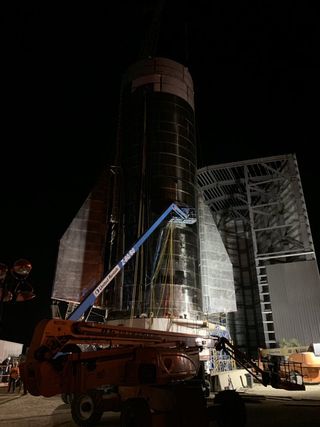
It looks like Elon Musk will have a pretty nice visual aid when he gives his highly anticipated Starship update this weekend.
On Saturday (Sept. 28), the SpaceX founder and CEO plans to reveal the latest design details of Starship and Super Heavy — the 100-passenger spaceship and the huge rocket, respectively, that the company is developing to send people to the moon, Mars and other distant destinations.
The talk will take place at SpaceX's South Texas facilities near the village of Boca Chica, where the company is building a Starship prototype known as the Mk1. And this test vehicle is really starting to take shape, as two photos Musk tweeted on Sunday (Sept. 22) reveal.
Related: SpaceX's Starship and Super Heavy Mars Rocket in Pictures
Adding the rear moving fins to Starship Mk1 in Boca Chica, Texas pic.twitter.com/HWLihqihphSeptember 22, 2019
One of the pictures shows technicians installing stability-controlling rear fins on Starship Mk1, Musk said. The other image shows the Mk1 bottom half, now finned up, apparently getting ready for a big construction milestone.
"Bottom half of Starship at night. Top half with forward fins & header tanks probably stacks on Wednesday. Three Raptors already installed," Musk wrote about this second photo.
In another Sunday tweet, Musk added that the Mk1 fairing — the protective "nose cone" that surrounds payloads during launch — will be mounted by Saturday. So, the billionaire entrepreneur will likely have a fully stacked Mk1 as his backdrop when he makes his presentation.
Get the Space.com Newsletter
Breaking space news, the latest updates on rocket launches, skywatching events and more!
The Raptor is the next-generation engine that will power Starship and Super Heavy. Both the Mk1 and the Mk2 — another prototype that SpaceX is developing at its Florida facilities — will feature at least three Raptors, Musk has said. (The goal is to improve the final Starship design via some intracompany competition.)
As currently envisioned, the final Starship will have six Raptors and the Super Heavy 35 of these engines. But those numbers could change; we'll have to wait until Saturday to learn more.
The Mk1 and Mk2 are second-generation Starship prototypes. The first, a stubby vehicle known as Starhopper, sported just a single Raptor. Starhopper was retired last month after acing its second untethered test flight, a Boca Chica jaunt that took the craft about 500 feet (150 meters) into the air and featured a sideways translation to a landing pad.
We should see the Mk1 in action soon. SpaceX aims to fly the vehicle to an altitude of about 12 miles (20 kilometers) in October, then attempt an orbital test flight shortly thereafter, Musk has said.
Things should continue to move quickly if these flights go well. SpaceX representatives have said that the first operational Starship-Super Heavy flight could occur as early as 2021. The initial commercial launches will likely loft communications satellites, but passenger flights may not be far behind: Japanese billionaire Yusaku Maezawa has booked a round-the-moon Starship mission, which is currently targeted for 2023.
- Elon Musk: Revolutionary Private Space Entrepreneur
- See the Evolution of SpaceX's Rockets in Pictures
- SpaceX: First Private Flights to Space Station
Mike Wall's book about the search for alien life, "Out There" (Grand Central Publishing, 2018; illustrated by Karl Tate), is out now. Follow him on Twitter @michaeldwall. Follow us on Twitter @Spacedotcom or Facebook.
Join our Space Forums to keep talking space on the latest missions, night sky and more! And if you have a news tip, correction or comment, let us know at: community@space.com.

Michael Wall is a Senior Space Writer with Space.com and joined the team in 2010. He primarily covers exoplanets, spaceflight and military space, but has been known to dabble in the space art beat. His book about the search for alien life, "Out There," was published on Nov. 13, 2018. Before becoming a science writer, Michael worked as a herpetologist and wildlife biologist. He has a Ph.D. in evolutionary biology from the University of Sydney, Australia, a bachelor's degree from the University of Arizona, and a graduate certificate in science writing from the University of California, Santa Cruz. To find out what his latest project is, you can follow Michael on Twitter.
